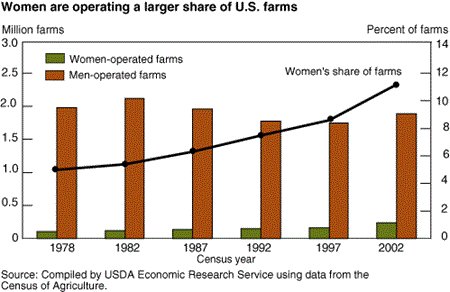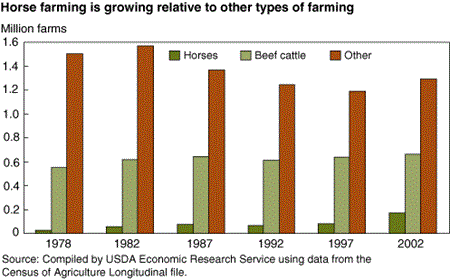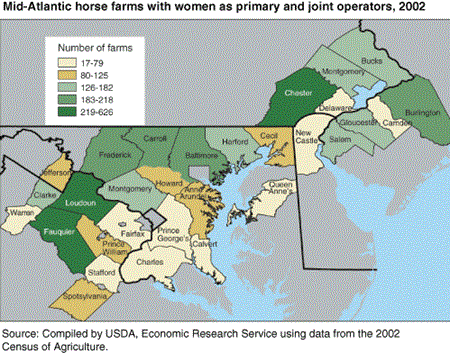Data Feature
More Women Turning to Horse Farming
According to the 2002 Census of Agriculture, the number of farms operated primarily by women more than doubled since 1978, the first year that such information was recorded. Over the same period, the growth in numbers of horse farms far outpaced that of either beef cattle or other types of crop and livestock farms.
The Census of Agriculture defines a horse farm as a USDA farm that generates 50 percent or more of its sales from horses. (A USDA farm is an operation that sells at least $1,000 of agricultural products in a year.) Riding stables and other equestrian recreational facilities could be counted in the Census if these operations sell horses and operate like a farm.
Equestrian sports driving increase in horse farms
The increase in horse farms is largely attributed to the growth in participation in equestrian sports and recreation. While the horse racing industry has declined in popularity over the last 20 years, other horse sports—including show jumping and field hunting, driving, cutting, roping, eventing, dressage, and endurance—have expanded their appeal. Jockey Club Thoroughbred foal registration (an indicator of the number of race horses expected to race) dropped by about a quarter from the 1980s to the 1990s, while the U.S. horse and pony inventory as measured by the Census of Agriculture almost doubled during that time.
Horse farming is compatible with other goals
Given that the demand for horses is derived from the growth in participation in equestrian sports, it follows that horse farms will locate near major population centers. At the same time, horse farming may be particularly compatible as a peri-urban agricultural activity. Horse operations with pasture and sporting facilities provide open space, consistent with the land-use objectives of many suburban jurisdictions. In suburban Washington, DC, for example, the 93,000 acres in the Agricultural Reserve in Montgomery County, Maryland, is an area zoned to protect farmland. There, over the past 25 years, the number of horse farms more than doubled while the number of cattle farms fell by 50 percent, and total farm numbers declined by 15 percent.
Also supportive of goals to preserve agriculture, horse farms provide income to other farms and to a variety of agriculture-related businesses. Like other livestock operations, most horse farms purchase feed and hay, and peripheral equipment like tractors, trucks, trailers, farm structures, and fencing. In addition, horse farms purchase equine equipment and obtain services from farriers and veterinarians.
Share of horse farms operated by women has more than doubled since 1978
The significance of women in horse farming is far higher than in other types of farming. By 2002, women were the primary operators of almost a third of all U.S. horse farms. Women farmers, singly and jointly, operated over 65 percent of all horse farms, compared with 37 percent of all farms. Of all the farms operated primarily by women, one-fifth were horse farms.
As to why women appear to have been disproportionately attracted to horse farming, answers are conjectural. It has always been the case that women operators were more likely than men to be involved in livestock farms and also that women operated on smaller acreages than farms operated by men, so women’s increasing presence in horse farming is consistent with that history.
Mid-Atlantic region has longstanding equestrian roots
Clues about the dynamics of the horse industry may be revealed through a closer look at the mid-Atlantic region, where equestrian roots date to colonial times (jousting is the State sport of Maryland). The presence of women-operated horse farms is particularly extensive in this region, where, in 2002, women operated 48 percent of all horse farms. Women as primary and joint owners in this area operate over half of all horse farms; in some counties, their total involvement reaches nearly 80 percent. Why so many women? One hypothesis is that higher income women (and their households) are present in larger numbers in metropolitan areas (of which the mid-Atlantic region has several), and these women may be better positioned financially to enter the horse industry. Census data lend some support to this idea: nationwide, women who are primary horse farm operators were more likely to work off the farm than other women farm operators in 2002; however, they were still less likely to work off the farm than men who are horse farm operators.
There may be lessons to learn from the growth in women-owned horse farms that could enhance strategies to encourage women to enter agriculture. Inquiry could be made as to whether it is the scale of the operation that is particularly attractive to women, or the positive business outlook, or the proximity to off-farm employment. It might, of course, just be the horses.
Structural and Financial Characteristics of U.S. Farms: 2004 Family Farm Report, by David Banker and James M. MacDonald, USDA, Economic Research Service, March 2005





